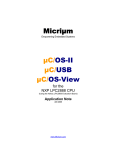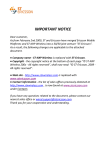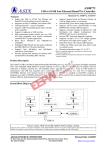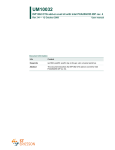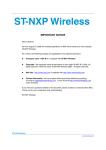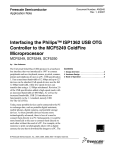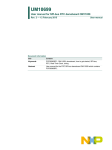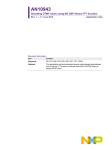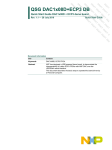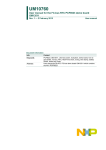Download User Manual
Transcript
IMPORTANT NOTICE Dear customer, As from February 2nd 2009, ST and Ericsson have merged Ericsson Mobile Platforms and ST‐NXP Wireless into a 50/50 joint venture "ST‐Ericsson". As a result, the following changes are applicable to the attached document. ● Company name ‐ ST‐NXP Wireless is replaced with ST‐Ericsson. ● Copyright ‐ the copyright notice at the bottom of each page “© ST‐NXP Wireless 200x ‐ All rights reserved”, shall now read: “© ST‐Ericsson, 2009 ‐ All rights reserved”. ● Web site ‐ http://www.stnwireless.com is replaced with www.stericsson.com ● Contact information ‐ the list of sales offices previously obtained at http://www.stnwireless.com , is now found at www.stericsson.com under Contacts If you have any questions related to the document, please contact our nearest sales office or [email protected]. Thank you for your cooperation and understanding. AN10047 Handheld devices using the ISP1582; ISP1583 Rev. 04 — 20 February 2009 Application note Document information Info Content Keywords isp1582, isp1583, usb, universal serial bus Abstract This is an application note on handheld devices using the ISP1582 or ISP1583. ST-NXP Wireless AN10047 ST-NXP Wireless Handheld devices using the ISP1582/3 Revision history Rev Date Description 04 20090220 Globally changed NXP Semiconductors and NXP to ST-NXP Wireless. Also updated the legal text. 03 20080121 Third release. Updated Section 2 02 20060906 Second release. Section 2.1: updated the second paragraph. 01 20050301 First release. Contact information For additional information, please visit: http://www.stnwireless.com For sales office addresses, please send an email to: [email protected] AN10047_4 Application note © ST-NXP Wireless. All rights reserved. Rev. 04 — 20 February 2009 2 of 8 AN10047 ST-NXP Wireless Handheld devices using the ISP1582/3 1. Introduction This document explains the application of handheld devices using the ISP1582 or ISP1583. 2. Power mode Handheld devices can be powered using either power-sharing mode or bus-powered mode. The ISP1582 supports bus-powered mode and the ISP1583 supports both bus-powered and power-sharing modes. 2.1 Power-sharing mode As can be seen in Fig 1, in power-sharing mode, VCC(3V3) is supplied by the output of the 5 V-to-3.3 V voltage regulator. The input to the regulator is from VBUS. VCC(I/O) is supplied through the power source of the system. When the USB cable is plugged in, the ISP1583 goes through the power-on reset cycle. In this mode, OTG is disabled. In power-sharing mode, it is recommended that you connect pull-up signals to VCC(I/O) instead of VCC(3V3). This is to ensure that when VBUS is lost, interfacing signals are properly handled. Connect RPU to VCC(3V3) through a 1.5 kΩ pull-up resistor. Fig 1. Power-sharing mode In power-sharing mode, the processor will experience continuous interrupt when VBUS is lost; see Fig 2. This is because the default status of the interrupt pin when operating in sharing mode with VBUS not present is LOW. To overcome this, implement external VBUS AN10047_4 Application note © ST-NXP Wireless. All rights reserved. Rev. 04 — 20 February 2009 3 of 8 AN10047 ST-NXP Wireless Handheld devices using the ISP1582/3 sensing circuitry. The output from the voltage regulator can be connected to pin GPIO of the processor to qualify the interrupt from the ISP1583. Fig 2. Interrupt pin status during power off in power-sharing mode 2.2 Bus-powered mode In bus-powered mode, VCC(3V3) and VCC(I/O) are supplied by the output of the 5 V-to-3.3 V voltage regulator; see Fig 3. The input to the regulator is from VBUS. On plugging in the USB cable, the ISP1582/3 goes through the power-on reset cycle. In this mode, OTG is disabled. Fig 3. Bus-powered mode 3. Suspending a device In the following subsections, you will find the recommended sequence to properly suspend the ISP1582/3 to achieve lowest power consumption for various scenarios. This is because most handheld devices are battery operated, and are required to work in lowest power consumption mode when in idle state. AN10047_4 Application note © ST-NXP Wireless. All rights reserved. Rev. 04 — 20 February 2009 4 of 8 AN10047 ST-NXP Wireless Handheld devices using the ISP1582/3 3.1 Connecting a DC charger to the USB port Some handheld devices may have battery charging through the USB port. These devices may encounter problems, such as waking up the ISP1582/3 unnecessarily when the DC charger is connected to the USB port. The ISP1582/3 can be woken up from suspend in any of the following ways: • Activities on the bus • Wake-up on chip select • Using the WAKEUP pin • Presence of VBUS The following steps can be used to set the ISP1582/3 into suspend mode, if a DC charger is connected to the USB port instead of a USB cable. 1. The device must be in suspend mode. It is recommended, though not necessary, that the device is interrupt driven. The device must have the VBUS present interrupt enabled. 2. On detecting the presence of a VBUS interrupt or the VBUS status bit, issue an unlock command by using the Unlock Device register (7Ch) to unlock the chip. Write unlock code AA37h to the Unlock Device register. 3. Issue a soft reset and enable SoftConnect 1 . A soft reset is needed if you do not know the previous states of the ISP1582/3. Soft reset can be performed using the Mode register (0Ch). In the Mode register, write logic 1 followed by logic 0 to the SFRESET bit to enable the software initiated reset to the ISP1582/3. The ISP1582/3 must be reinitialized to the default setting. If, however, the ISP1582/3 is reset before the DC charger is connected to the USB port, you may just enable the SoftConnect (SOFTCT) bit in the Mode register. Writing logic 1 to bit SOFTCT will enable the connection of the 1.5 kΩ pull-up resistor on pin RPU to the DP line. The device is now ready for bus enumeration. Steps 1 to 3 are for the systems that do not know whether VBUS is from a DC charger or a USB cable. This makes the firmware easier to manage. 4. If a DC charger is connected to the USB port, there will be no activity on the bus and the microcontroller will receive a suspend interrupt. After the microcontroller has received the suspend interrupt, the microcontroller can set the ISP1582/3 to sleep mode again. If the connection is using a USB cable, then the device is ready for bus enumeration. 5. If your system has masked off the interrupt and can detect that VBUS is from the DC charger, it is advisable to wait for more than 3 ms. The delay is required for the ISP1582/3 to enter the correct internal state. This is prompted by the ISP1582/3 through the interrupt when the ISP1582/3 is ready for suspend. 3.2 Low-battery situation When the battery for handheld devices is low while there is communication between the host and peripheral, that is, with the USB cable connected, the ISP1582/3 must be set into suspend mode. The following steps can be performed to suspend the ISP1582/3: 1 SoftConnect is a trademark of ST-NXP Wireless. AN10047_4 Application note © ST-NXP Wireless. All rights reserved. Rev. 04 — 20 February 2009 5 of 8 AN10047 ST-NXP Wireless Handheld devices using the ISP1582/3 1. Force the ISP1582/3 into full-speed mode by writing logic 1 to the FORCEFS bit in the Test Mode register (84h). 2. Disable SoftConnect by writing logic 0 to the SOFTCT bit in the Mode register (0Ch). 3. Issue a soft reset to the ISP1582/3 by writing logic 1, followed by logic 0 to the SFRESET bit in the Mode register. 4. Wait for a minimum of 3 ms, before sending the ISP1582/3 back into suspend mode. 4. Device suspend current Table 1 shows the suspend current measurement of the ISP1582/3 under various conditions. Table 1. Suspend current measurement CLKAON Supply voltage Test conditions Core (mA) I/O (mA) VCC = 3.3 V Suspend with PLL on 19.60 3.48 Suspend with PLL off; VBUS present; SoftConnect on 0.107 3.48 0.105 3.52 VCC(I/O) = 3.3 V Suspend with PLL off; VBUS present; SoftConnect off VCC = 3.3 V Suspend with PLL off; VBUS not present 0.107 3.50 On VCC(IO) = 3.3 V Off VCC = 3.3 V VCC(IO) = 3.3 V Off Off VCC = 3.3 V VCC(IO) = 3.3 V AN10047_4 Application note © ST-NXP Wireless. All rights reserved. Rev. 04 — 20 February 2009 6 of 8 AN10047 ST-NXP Wireless Handheld devices using the ISP1582/3 5. Legal information Please Read Carefully: Information in this document is provided solely in connection with ST-NXP products. ST-NXP Wireless NV and its subsidiaries (“ST-NXP”) reserve the right to make changes, corrections, modifications or improvements, to this document, and the products and services described herein at any time, without notice. All ST-NXP products are sold pursuant to ST-NXP’s terms and conditions of sale. Purchasers are solely responsible for the choice, selection and use of the ST-NXP products and services described herein, and ST-NXP assumes no liability whatsoever relating to the choice, selection or use of the ST-NXP products and services described herein. No license, express or implied, by estoppel or otherwise, to any intellectual property rights is granted under this document. If any part of this document refers to any third party products or services it shall not be deemed a license grant by ST-NXP for the use of such third party products or services, or any intellectual property contained therein or considered as a warranty covering the use in any manner whatsoever of such third party products or services or any intellectual property contained therein. UNLESS OTHERWISE SET FORTH IN ST-NXP’S TERMS AND CONDITIONS OF SALE ST-NXP DISCLAIMS ANY EXPRESS OR IMPLIED WARRANTY WITH RESPECT TO THE USE AND/OR SALE OF ST-NXP PRODUCTS INCLUDING WITHOUT LIMITATION IMPLIED WARRANTIES OF MERCHANTABILITY, FITNESS FOR A PARTICULAR PURPOSE (AND THEIR EQUIVALENTS UNDER THE LAWS OF ANY JURISDICTION), OR INFRINGEMENT OF ANY PATENT, COPYRIGHT OR OTHER INTELLECTUAL PROPERTY RIGHT. UNLESS EXPRESSLY APPROVED IN WRITING BY AN AUTHORIZED ST-NXP REPRESENTATIVE, ST-NXP PRODUCTS ARE NOT RECOMMENDED, AUTHORIZED OR WARRANTED FOR USE IN MILITARY, AIR CRAFT, SPACE, LIFE SAVING, OR LIFE SUSTAINING APPLICATIONS, NOR IN PRODUCTS OR SYSTEMS WHERE FAILURE OR MALFUNCTION MAY RESULT IN PERSONAL INJURY, DEATH, OR SEVERE PROPERTY OR ENVIRONMENTAL DAMAGE. ST-NXP PRODUCTS WHICH ARE NOT SPECIFIED AS "AUTOMOTIVE GRADE" MAY ONLY BE USED IN AUTOMOTIVE APPLICATIONS AT USER’S OWN RISK. Resale of ST-NXP products with provisions different from the statements and/or technical features set forth in this document shall immediately void any warranty granted by ST-NXP for the ST-NXP product or service described herein and shall not create or extend in any manner whatsoever, any liability of ST-NXP. ST-NXP and the ST-NXP logo are trademarks or registered trademarks of ST-NXP in various countries. Information in this document supersedes and replaces all information previously supplied. The ST-NXP logo is a registered trademark of ST-NXP Wireless. All other names are the property of their respective owners. © 2009 ST-NXP Wireless - All rights reserved ST-NXP Wireless group of companies Belgium - Brazil - Canada - China - Czech Republic - Finland - France - Germany - India - Italy - Japan - Korea - Malaysia - Mexico Netherlands - Singapore - Sweden - Switzerland - Taiwan - United Kingdom - United States of America www.stnwireless.com AN10047_4 Application note © ST-NXP Wireless. All rights reserved. Rev. 04 — 20 February 2009 7 of 8 ST-NXP Wireless AN10047 Handheld devices using the ISP1582/3 6. Contents 1. 2. 2.1 2.2 3. 3.1 3.2 4. 5. 6. Introduction ......................................................... 3 Power mode .........................................................3 Power-sharing mode .......................................... 3 Bus-powered mode ............................................ 4 Suspending a device ........................................... 4 Connecting a DC charger to the USB port ......... 5 Low-battery situation .......................................... 5 Device suspend current ...................................... 6 Legal information ................................................ 7 Contents ...............................................................8 Please be aware that important notices concerning this document and the product(s) described herein, have been included in the section 'Legal information'. © ST-NXP Wireless 2009. All rights reserved. For more information, please visit: http://www.stnwireless.com For sales office addresses, email to: [email protected] Date of release: 20 February 2009 Document identifier: AN10047_4










